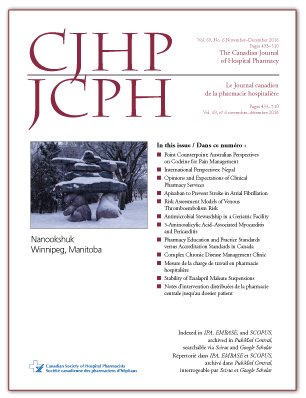Appropriateness of Apixaban Dosing to Prevent Stroke in Patients with Atrial Fibrillation: A Pilot Study
DOI:
https://doi.org/10.4212/cjhp.v69i6.1607Keywords:
apixaban, anticoagulation, atrial fibrillation, stroke, evaluation of medication utilization, anticoagulothérapie, fibrillation auriculaire, accident vasculaire cérébral, évaluation de l’utilisation des médicamentsAbstract
ABSTRACT
Background: The ARISTOTLE study investigated apixaban, at a dose of 5 mg PO bid, for the prevention of stroke in patients with atrial fibrillation; however, it has been noted anecdotally that many patients are receiving 2.5 mg PO bid, despite being eligible for the full dosage. A recent study examining the use of dabigatran and rivaroxaban found that many patients were receiving these medications inappropriately; however, a literature search conducted in April 2016 showed that apixaban had not been formally studied in this context.
Objective: To evaluate the appropriateness of apixaban dosing for stroke prevention in patients with atrial fibrillation, relative to the dose used in the ARISTOTLE study and recommendations in the product monograph.
Methods: This retrospective chart review was conducted at a 300-bed Canadian teaching hospital. All inpatients with atrial fibrillation for whom apixaban was prescribed for stroke prevention in March 2015 were considered for inclusion. The appropriateness of apixaban dosing was determined in relation to the ARISTOTLE methodology and product monograph recommendations (i.e., 5 mg PO bid, with a lower dosage of 2.5 mg PO bid if warranted on the basis of age, weight, or serum creatinine level).
Results: A total of 47 patients were included, of whom 25 (53%) were receiving apixaban inconsistent with the ARISTOTLE study and the product monograph. Limitations of the current study included small sample size, single-centre setting, and retrospective design, which precluded determination of each prescriber’s rationale for dosage choice.
Conclusions: Pharmacists and physicians should be vigilant in ensuring that patients with atrial fibrillation are receiving the appropriate dosage of apixaban to optimize the risk–benefit ratio of this therapy.
RÉSUMÉ
Contexte : L’étude ARISTOTLE portait sur l’utilisation de l’apixaban pour la prévention des accidents vasculaires cérébraux (AVC) chez les patients souffrant de fibrillation auriculaire à raison d’une dose de 5 mg par voie orale deux fois par jour. Or, des observations empiriques montrent que bon nombre de patients reçoivent une dose de 2,5 mg par voie orale deux fois par jour, même s’ils se qualifient pour la pleine dose. Une étude récente portant sur l’utilisation du dabigatran et du rivaroxaban a relevé que bon nombre de patients recevaient ces médicaments de façon inappropriée. Or, une recherche bibliographique effectuée en avril 2016 a révélé que l’apixaban n’a pas été officiellement étudié dans ce contexte.
Objectif : Évaluer la pertinence du schéma posologique d’apixaban pour la prévention des AVC chez les patients souffrant de fibrillation auriculaire comparativement à la dose utilisée dans l’étude ARISTOTLE et aux recommandations contenues dans la monographie de produit.
Méthodes : La présente analyse rétrospective de dossiers médicaux a été menée dans un seul centre hospitalier universitaire canadien de 300 lits. Tous les patients hospitalisés atteints de fibrillation auriculaire pour qui l’on a prescrit de l’apixaban afin de prévenir l’AVC en mars 2015 ont été pris en considération. La pertinence du schéma posologique d’apixaban était établie par rapport à la méthodologie de l’étude ARISTOTLE et aux recommandations de la monographie de produit (c’est-à-dire une dose de 5 mg par voie orale deux fois par jour et une dose réduite de 2,5 mg par voie orale deux fois par jour si l’âge, le poids et le taux de créatinine sérique la justifiaient).
Résultats : Au total, 47 patients ont été admis. L’administration de l’apixaban n’était pas conforme à l’étude ARISTOTLE et à la monographie de produit chez 25 (53 %) d’entre eux. Parmi les limites de la présente étude, on comptait la petite taille de l’échantillon, son déroulement dans un seul centre et l’utilisation d’un plan d’étude rétrospectif qui empêchait de
comprendre les raisons motivant le choix de posologie de chaque prescripteur.
Conclusions : Les pharmaciens et les médecins doivent être vigilants et s’assurer que les patients atteints de fibrillation auriculaire reçoivent la posologie appropriée d’apixaban permettant d’optimiser le rapport bénéfice-risque de ce traitement.
Downloads
Published
Issue
Section
License
After publication of a manuscript in the CJHP, the authors of the manuscript must obtain written permission from the CSHP (publications@cshp.ca) before reproducing any text, figures, tables, or illustrations from the work in future works of their own. If a submitted manuscript is declined for publication in the CJHP, all said rights shall revert to the authors. Please note that any forms (e.g., preprinted orders and patient intake forms) used by a specific hospital or other health care facility and included as illustrative material with a manuscript are exempt from this copyright transfer. The CJHP will require a letter from the hospital or health care facility granting permission to publish the document(s).
Copyright © Canadian Society of Hospital Pharmacists.









